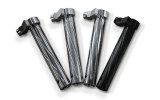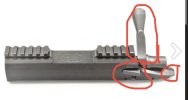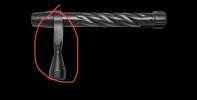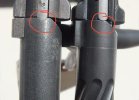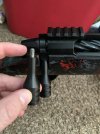Give me a call, we'll set it up.That is a trip I am willing to make. I have travel benefits so airfare is cheap for me. I wouldn't benefit from the training, I am too old and my long range hunting days are behind me. I just want a few nice custom rifles to hunt with and I am not afraid to ask for an education on subjects I know just enough about to stumble my way thru.
You are using an out of date browser. It may not display this or other websites correctly.
You should upgrade or use an alternative browser.
You should upgrade or use an alternative browser.
60* or 90*, preference? One better than the other?
- Thread starter Darryle
- Start date
 Help Support Long Range Hunting Forum
Help Support Long Range Hunting Forum
Fiftydriver
Official LRH Sponsor
Generally, if you have a 90* and a 60* bolt and both have a 25 lb firing spring for example, and if both bolts striker assemblies need to be pulled back the same distance to the fully cocked position. The 60* bolt has to move the striker assembly the same distance back but in a shorter rotational distance. That means that the angle on the cocking piece will be a sharper angle. To cover the same rearward distance with shorter rotational distance requires a steeper cam angle.And Mark V's have NINE LUGS...I can't imagine how I work that bolt....without a HAMMER! Some folks thinking ( certainly not reasoning) astounds me!!
steeper cam angle with same weight firing pin spring results in a heavier load on the cam and as a result on the bolt handle. Now you may have rifles with relatively mild firing pin springs and this may not even be noticeable but in reality, the 90* bolt can use a less aggressive cam angle for the cocking piece.
another way to look at it, imagine your rolling a 100 lb drum up two ramps, each 10 feet high. One ramp is a 20 degree angle grade, the other is a 45 degree angle grade. 100 lb drum is much harder to roll up a 45* angle then a 20* angle. Same idea here, just much smaller scale.
Bingo. Exactly what I was describing earlier in thread. You have to give up spring rate/weight to achieve equal bolt handle lift force... and you're most often giving up ignition uniformity when you do. Primers are the limiting factor here. They need to be hit hard enough to start all of this correctly.Generally, if you have a 90* and a 60* bolt and both have a 25 lb firing spring for example, and if both bolts striker assemblies need to be pulled back the same distance to the fully cocked position. The 60* bolt has to move the striker assembly the same distance back but in a shorter rotational distance. That means that the angle on the cocking piece will be a sharper angle. To cover the same rearward distance with shorter rotational distance requires a steeper cam angle.
steeper cam angle with same weight firing pin spring results in a heavier load on the cam and as a result on the bolt handle. Now you may have rifles with relatively mild firing pin springs and this may not even be noticeable but in reality, the 90* bolt can use a less aggressive cam angle for the cocking piece.
another way to look at it, imagine your rolling a 100 lb drum up two ramps, each 10 feet high. One ramp is a 20 degree angle grade, the other is a 45 degree angle grade. 100 lb drum is much harder to roll up a 45* angle then a 20* angle. Same idea here, just much smaller scale.
There are tricks you can do to limit it, such as pushing some of your cocking force over to the bolt closing, rather than opening. ... but I don't like those methods as they introduce their own unique problems.
-----------
Follow on Instagram
Subscribe on YouTube
Amazon Affiliate

Ok, that makes complete sense in easy to understand terms for us less experienced.
Now, what about how Terminus deals with that? Would this "level" the playing on the bolt lift issue?
That leaves the NPA issue and potential strength/weakness issue of the lower 3rd lug, anything else I am missing?

Now, what about how Terminus deals with that? Would this "level" the playing on the bolt lift issue?
That leaves the NPA issue and potential strength/weakness issue of the lower 3rd lug, anything else I am missing?
- Roller tipped cocking piece for smooth cocking operation
The weight that must be lifted is still greater, no matter how frictionless the cam to cocking piece interface.Ok, that makes complete sense in easy to understand terms for us less experienced.
Now, what about how Terminus deals with that? Would this "level" the playing on the bolt lift issue?
That leaves the NPA issue and potential strength/weakness issue of the lower 3rd lug, anything else I am missing?
View attachment 384192
RockyMtnUT
Well-Known Member
The friction plays into it the equation. Along with others
Ok, so even with this "roller tipped" cocking piece the friction is still greater.
That is good information to have available.
This kinda goes down a new rabbit hole, but since we have kinda determined that the 90* is the preferred design.
What seperates a great 700 clone from a good 700 clone? Besides footprint and triggers, what is something that one or more manufacturers do to "elevate/separate" themselves from the other clones?
I am a huge fan of the integral recoil lug, threaded trigger pins, Wyatt's cut or centerfeed DBM magazines, tool less firing pin bolt disassembly and pinned optics mounts with the more robust screw attachments myself.
I am strictly talking about standard, non-magnum calibers, Ackleyized 270/280/30'06 cartridges and their wildcats. There is nothing in Texas that I can (or plan to) hunt that requires a magnum cartridge. That and I am too old to be beat on with needless recoil that serves me no purpose or can't be overcome with bullet selection.
That is good information to have available.
This kinda goes down a new rabbit hole, but since we have kinda determined that the 90* is the preferred design.
What seperates a great 700 clone from a good 700 clone? Besides footprint and triggers, what is something that one or more manufacturers do to "elevate/separate" themselves from the other clones?
I am a huge fan of the integral recoil lug, threaded trigger pins, Wyatt's cut or centerfeed DBM magazines, tool less firing pin bolt disassembly and pinned optics mounts with the more robust screw attachments myself.
I am strictly talking about standard, non-magnum calibers, Ackleyized 270/280/30'06 cartridges and their wildcats. There is nothing in Texas that I can (or plan to) hunt that requires a magnum cartridge. That and I am too old to be beat on with needless recoil that serves me no purpose or can't be overcome with bullet selection.
No, that's not what I said. Not friction, lift force. The rollers on the cocking pieces "can" reduce friction when executed properly. However, I've found they are entirely un-needed... and the first time you have one break off and get lodged in your action... you'll never run one again. There are several manufacturers that have been able to solve the cocking piece binding issue without using a roller.Ok, so even with this "roller tipped" cocking piece the friction is still greater.
A great 700 clone carries over the footprint for the action inlet... and that's about it. Material selection, material treatment/coating, extractor design, ejector placement/design, tolerances for fitment, bolt fluting, firing pin shape and features, integral recoil lug, integral rail, 1-piece bolts, etc etc. A Lone Peak Fuzion or BAT TR has almost nothing in common with a rem700.
It's all about how it feels/operates and how repeatable the ignition components are. The ability to quickly get back in battery with minimal disruption to the rifle. How strong the extraction system is. How reliable ejection is. How many thousand rounds can it go and maintain that capability.
Consider the tail end of this video.
Round count is one of the ultimate factors which determine which actions are great rather than just good. There are lots of actions that are great once they get broke in. Then they stop being great after about 2,000 rounds. They can become downright trash after 5,000.
-----------
Follow on Instagram
Subscribe on YouTube
Amazon Affiliate

brcfo_outdoors
Well-Known Member
Ok, so even with this "roller tipped" cocking piece the friction is still greater.
That is good information to have available.
This kinda goes down a new rabbit hole, but since we have kinda determined that the 90* is the preferred design.
What seperates a great 700 clone from a good 700 clone? Besides footprint and triggers, what is something that one or more manufacturers do to "elevate/separate" themselves from the other clones?
I am a huge fan of the integral recoil lug, threaded trigger pins, Wyatt's cut or centerfeed DBM magazines, tool less firing pin bolt disassembly and pinned optics mounts with the more robust screw attachments myself.
I am strictly talking about standard, non-magnum calibers, Ackleyized 270/280/30'06 cartridges and their wildcats. There is nothing in Texas that I can (or plan to) hunt that requires a magnum cartridge. That and I am too old to be beat on with needless recoil that serves me no purpose or can't be overcome with bullet selection.
I can only really speak to Bighorn/Zermatt arms because that is what I am most familiar with. I have a TL3, and it checks all of the boxes you mentioned (go SR3 for the Wyatt's Cut) other than the threaded trigger pins. What I additionally like about it, is the swappable floating bolt head. I decided I didn't need another 6.5 so I bought a new prefit and a new bolt head and how I have a 300WSM on the same action. Whether that is a feature you need or want, obviously only you can determine. The availability of prefit barrels is also a plus just based on the popularity of those actions, and I assume would be available even in the cartridges you are planning on, though you may have to shop around a little. The TL3 was originally marketed for tactical shooters and they seem to behave well when they get dirt in them where I have seen several reports of Defiance actions locking up under paltry PRS "conditions". The TL3 also lacks any kind of additional trigger hanger which I see no value in other than to complicate stock fitting. Overall I have been pleased with the simple design, straight forward reliability, and ease of working on.
hunter0528
Well-Known Member
What about straight Pulls? No interference with any scope, full grip on the case head, not just an extractor claw, and very fast with out having to lower the rifle to operate the bolt.
Blaser and Savage.
Blaser and Savage.
Blaser is definitely the king of getting back in battery with very little disruption of NPA. However, straight pull designs have struggled to get market penetration. They don't seem to be available in desirable configurations for the high precision/accuracy crowd. I haven't seen much of a blaser punching sub-1/3moa. In fairness, they just aren't around.What about straight Pulls? No interference with any scope, full grip on the case head, not just an extractor claw, and very fast with out having to lower the rifle to operate the bolt.
Blaser and Savage.
Even Euro Optic couldn't make a go of it, and if any company could succeed in having those rifles penetrate the US market, it would be them.
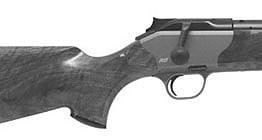
Zero listed anymore on their site.
There are limitations with these designs. I won't even start on savage. lol
-----------
Follow on Instagram
Subscribe on YouTube
Amazon Affiliate

RockyMtnUT
Well-Known Member
This is a rabbit hole for sure.What seperates a great 700 clone from a good 700 clone? Besides footprint and triggers, what is something that one or more manufacturers do to "elevate/separate" themselves from the other clones?
I am a huge fan of the integral recoil lug, threaded trigger pins, Wyatt's cut or centerfeed DBM magazines, tool less firing pin bolt disassembly and pinned optics mounts with the more robust screw attachments myself.
We really have a lot of great options out there. It is all opinions. That what's great. We all find different specs in actions that speak to us differently.
I'll try to explain some of mine.
The bolt only for now. I can't stand "cheap"bolts. Now go easy on me. As material costs have increased along with other things manufactures have taken a more cost effective route to produce bolts. If you pay attention to older models they have the old style bolt handles. They have since changed too using that dang screw stud.
Example: instead of buying larger round bar stock to make a full length bolt handle they have opted for smaller bar stock. This requires less machine time,cost etc. Some manufactures waterjet from plate steel then is milled. I'm not a fan of plate.
I'll share a couple pics to show this. It creates more parts and not as clean look. I'm all about appearance along with function. Terminus, Bat Pierce and a couple others still have what I call a true one piece handle/bolt. Many are moving away from it. I hate tooling marks. They are in many actions. Fix the tooling and rates.
Another Example:
I have a lone peak here right now that is very smooth cycling bolt. I also
have a Pierce that is very smooth cycling bolt next to it.
I have had no less than 5 people in the last couple months close their eyes. I handed them both actions and asked them to cycle a few times. Every time, every. The same one is picked as the smoothest. Why? They are both held to good tolerances right? There are other factors that still play into it. Bolt diameter and very slight finish differences, etc. Are they both smooth? Yes.
Function : firing pin assemble, lugs, extractor etc I'm not going to touch on. The last picture will show why some bolts have a harder "bump". So much goes into them. Most manufacturers copy one and slightly vary to some extent.
I'll weight in on other items that I think are pros and cons with different models and manufactures later.
Action body will be next.
Attachments
Last edited:
Litehiker
Well-Known Member
If you are interested in straight pull actions then check out the SAVAGE Impulse straight pull. SAVGE looked at the European straight pull rifles and felt they could design it better.
I dunno if they succeeded but it's worth your time to get one in your hands for a comparison. Certainly the price will be lower than theEuropean versions. Plus the Impulse bolt handle is swappable from left to right side.
Of course for the lowest cost straight pull you can get a surplus Swiss army Schmidt-Reuben rifle. ;o)
I dunno if they succeeded but it's worth your time to get one in your hands for a comparison. Certainly the price will be lower than theEuropean versions. Plus the Impulse bolt handle is swappable from left to right side.
Of course for the lowest cost straight pull you can get a surplus Swiss army Schmidt-Reuben rifle. ;o)
This has turned out to be an interesting thread. There are so many options out there now. I have not considered many of the points brought up by some the very experienced members. I always just cycled the action for feel and relied on the manufacturer for QC. If I was shooting huge volumes or competing, I would pay more attention I guess. There is something about the straight pulls that make me a little nervous. About the time you put your hard earned money down to purchase a custom action, there will be something new hitting the market that supposedly is better.
